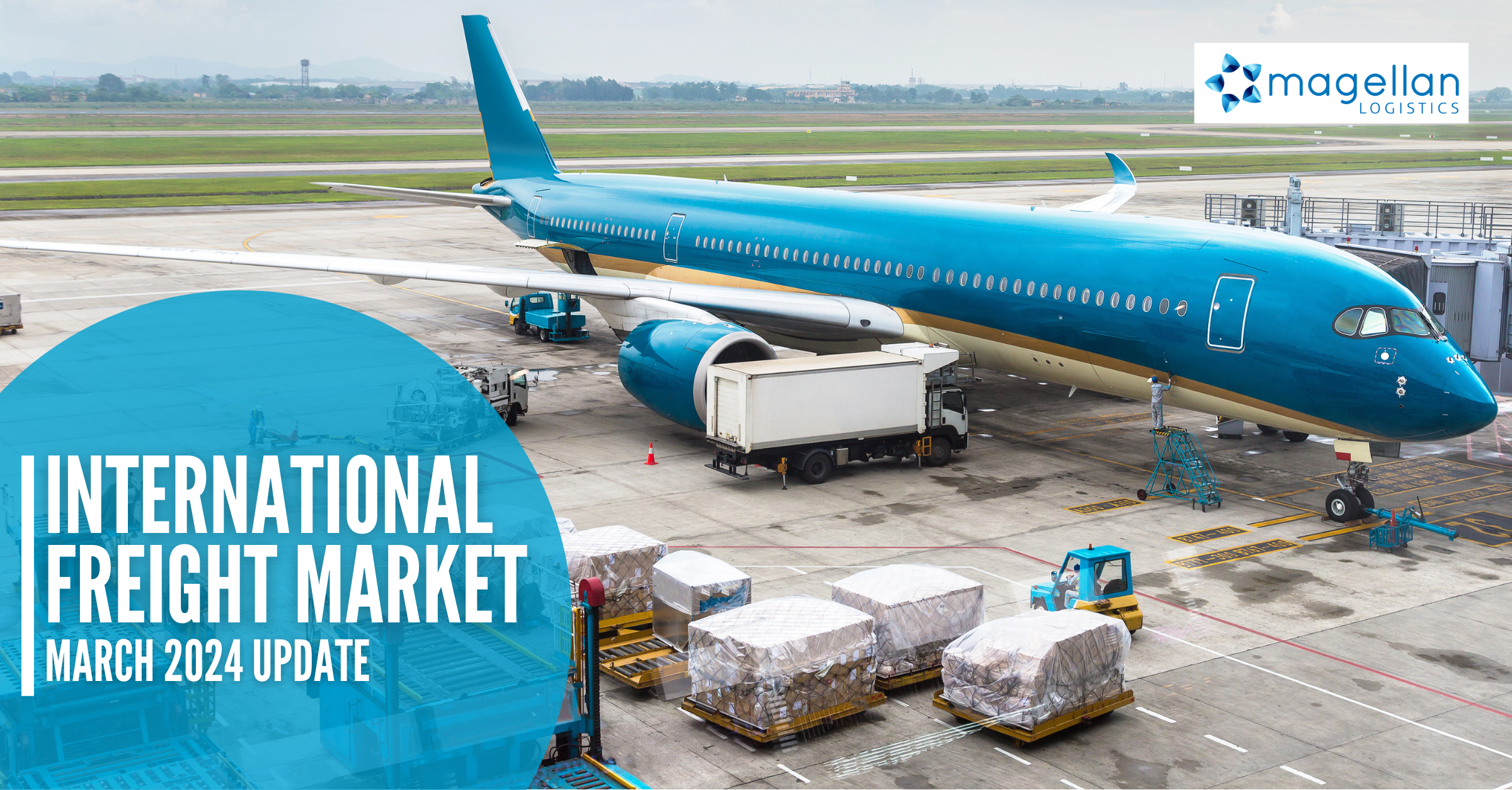This global freight market update sees Australia’s economy remaining relatively healthy despite ongoing warnings of a global recession. Inflation is slowing, and unemployment is low. With stocktake and EOFY almost behind us, preparations for peak season can begin. With that, we can expect to see the carriers’ GRIs and rate restoration tactics.
Freight market update
- May was the ninth consecutive month of decreasing freight rates.
- Global airfreight volumes and rates fell slightly last month, down 36% year on year. Overall capacity has increased by +15% compared with the previous year.
- Container depots at major ports are filling up with empty containers signalling potential container pileups and eventual port congestion and delays.
- Port of Melbourne on 31 May announced their Tariffs for Prescribed Services fee increase effective 1 July 2023.
- VICT has advised that since implementing their policy to weigh all containers, almost 25% of inbound containers have had confirmed gross weights outside of the 1 tonne tolerance allowed by VICT and have been penalised with a VGM discrepancy fee.
- Thirty-six sailing cancellations have been announced between weeks 26 and 30, representing a 5% cancellation rate. Cancelled sailings are expected to increase in the coming months as economic conditions worsen.
- Global average vessel delays continued to decrease to a little over five days, 2.41 days lower year on year.
- Global sea freight schedule reliability sat at 64.2% in April, up 29.9% year on year.
- Shipping line Q1 results showed EBIT dropped 81% year on year in 2023-Q1 to USD$7bn.
- Containership demolitions have resumed since late 2022 after freight rates began correcting to pre-Covid levels, although the pace has been slower than expected.
- Support for a global carbon tax on the shipping industry is gaining momentum with pressure from the French government and the World Bank.
- US regulators have advised of new screening rules which come into force on 31 October, where hard-to-screen cargo cannot travel by air unless shippers are enrolled in an authorised cargo security program.
- Maersk announced the new South East Asia to Australia Ocean network has now been fully implemented, offering improved flexibility and frequency with four weekly departures from South East Asia hub ports to Australia.
- Drought-hit Panama Canal postpones further depth restrictions after some much-needed rain. The administration said it would continue to monitor water levels.
- US West Coast Ports were severely affected by terminal closures due to action taken by workers negotiating new agreements.
- In September, the UK port of Felixstowe will roll out a 100-strong fleet of autonomous battery-powered trucks.
- The US unveils new shipping bills to clean up pollution and emissions. Ships with 10,000 gross tonnages or more would face a levy of $150 per ton on the carbon emissions of the fuel burned on the inbound trip, plus fees for the nitrogen oxides, sulphur dioxide and particle pollution emitted. This will raise approximately $250bn over ten years, providing critical funding for decarbonisation. They would end if the IMO implemented similar fees.
China / North Asia
Due to poor demand, only a portion (40-60%) of the announced GRIs were implemented in June. Current rates are expected to hold until mid-July. Any further increases are likely to be small.
Schedules are reliable, and cargo is moving efficiently; however, more blank sailings are likely due to slow demand and carriers’ attempts to arrest further rate drops.
For air freight, as more flights have been added, services are becoming more regular, and rates will continue to increase again.
South East Asia
The market from SE Asia to Australia is smooth sailing. No GRIs or blank sailings have been announced, rates remain stable, and terminals move cargo efficiently. Airfreight remains steady with some rate increases and improvements to capacities.
India
Market conditions are volatile concerning rates and volumes.
Mundra Port in Gujarat, India’s largest commercial port, has been impacted by a recent cyclone, resulting in significant delays.
Pakistan
Cyclone, Biparjoy, has disrupted schedules causing vessels to arrive off-schedule or be cancelled. Empty equipment is tight due to reduced imports, except in Karachi, where equipment is available.
North America
Ongoing labour disputes in the US are yet to resolve. Canada is also experiencing industrial unrest, with strikes potentially affecting key ports and operations.
Chassis shortages continue to cause delays in pickup and delivery at rail links.
Australia ports
Patrick Terminals
- Brisbane: Working with minimal delays approx. 0-0.5 day
- Fremantle: Working with minimal delays, approx. 0-0.5 day
- Sydney: Working with minimal delays, approx. 0-0.5 day
DP World Terminals
- Brisbane: Working with minimal delays approx. 0.5 days – mainly due to recent equipment and IT outages.
- Fremantle: Working with minimal delays, approx. 0-0.5 day
- Sydney: Working with minimal delays, approx. 0-0.5 day
- Melbourne: Working with minimal delays, approx. 0.5-1 day
VICT
- Melbourne: Working with minimal delays of 0-0.5 day
- Since the start of July, almost 25% of inbound containers have had confirmed gross weights outside of the 1-tonne tolerance and have been penalised with a VGM discrepancy fee.
AAT
- Brisbane: Severe congestion from May has eased, with PCC vessel delays down from 15 to 7 days.
- Port Kembla is still affected by severe congestion, with vessels queued for up to 15 days.
- Melbourne: Congestion at present.
Economic outlook
Europe
High inflation and tightening monetary policies continue to subdue eurozone growth. Gains in net exports and infrastructure projects partially offset consumer spending and inventory investment. Germany fell into recession, while Italy, Spain and France posted moderate growth. Tightening credit conditions are likely to continue to restrain consumer and business spending.
Americas
Recent consumer spending and construction data have shown more momentum than anticipated in the second quarter. However, another decline in real domestic income in the first quarter suggests a weaker economy than the expenditure data.
Asia Pacific
After an initial post-COVID-19 rebound, mainland China’s growth is slowing. Industrial production increased just 3.5% year on year in May, reflecting weak domestic and foreign demand. While state-owned firms’ fixed asset investment grew, private investment stagnated. The recovery in housing markets is uneven, and housing starts fell 22.7% year over year in the first five months of 2023. New government stimulus measures are not expected to spark a strong recovery.
Magellan Logistics provides freight and logistics services to all industries, including sea freight, air freight, customs clearance and the all-important digital freight portal providing 24/7 visibility of all your shipments. Keeping customers abreast of changing market conditions is critical in what we do. Our dedicated and professional team would love an opportunity to assist your business. If you have questions about the Freight Market Update, please get in touch on 1300 651 888.
Sources:
With thanks to the FTA for their Market Update













